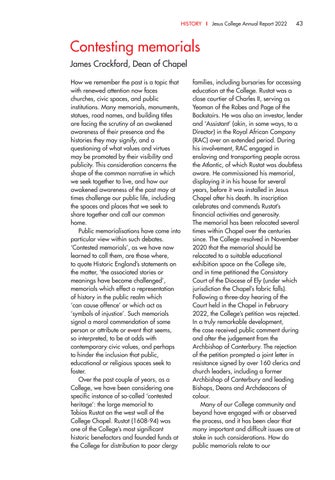HISTORY I Jesus College Annual Report 2022
43
Contesting memorials James Crockford, Dean of Chapel How we remember the past is a topic that with renewed attention now faces churches, civic spaces, and public institutions. Many memorials, monuments, statues, road names, and building titles are facing the scrutiny of an awakened awareness of their presence and the histories they may signify, and a questioning of what values and virtues may be promoted by their visibility and publicity. This consideration concerns the shape of the common narrative in which we seek together to live, and how our awakened awareness of the past may at times challenge our public life, including the spaces and places that we seek to share together and call our common home. Public memorialisations have come into particular view within such debates. ‘Contested memorials’, as we have now learned to call them, are those where, to quote Historic England’s statements on the matter, ‘the associated stories or meanings have become challenged’, memorials which effect a representation of history in the public realm which ‘can cause offence’ or which act as ‘symbols of injustice’. Such memorials signal a moral commendation of some person or attribute or event that seems, so interpreted, to be at odds with contemporary civic values, and perhaps to hinder the inclusion that public, educational or religious spaces seek to foster. Over the past couple of years, as a College, we have been considering one specific instance of so-called ‘contested heritage’: the large memorial to Tobias Rustat on the west wall of the College Chapel. Rustat (1608-94) was one of the College’s most significant historic benefactors and founded funds at the College for distribution to poor clergy
families, including bursaries for accessing education at the College. Rustat was a close courtier of Charles II, serving as Yeoman of the Robes and Page of the Backstairs. He was also an investor, lender and ‘Assistant’ (akin, in some ways, to a Director) in the Royal African Company (RAC) over an extended period. During his involvement, RAC engaged in enslaving and transporting people across the Atlantic, of which Rustat was doubtless aware. He commissioned his memorial, displaying it in his house for several years, before it was installed in Jesus Chapel after his death. Its inscription celebrates and commends Rustat’s financial activities and generosity. The memorial has been relocated several times within Chapel over the centuries since. The College resolved in November 2020 that the memorial should be relocated to a suitable educational exhibition space on the College site, and in time petitioned the Consistory Court of the Diocese of Ely (under which jurisdiction the Chapel’s fabric falls). Following a three-day hearing of the Court held in the Chapel in February 2022, the College’s petition was rejected. In a truly remarkable development, the case received public comment during and after the judgement from the Archbishop of Canterbury. The rejection of the petition prompted a joint letter in resistance signed by over 160 clerics and church leaders, including a former Archbishop of Canterbury and leading Bishops, Deans and Archdeacons of colour. Many of our College community and beyond have engaged with or observed the process, and it has been clear that many important and difficult issues are at stake in such considerations. How do public memorials relate to our































